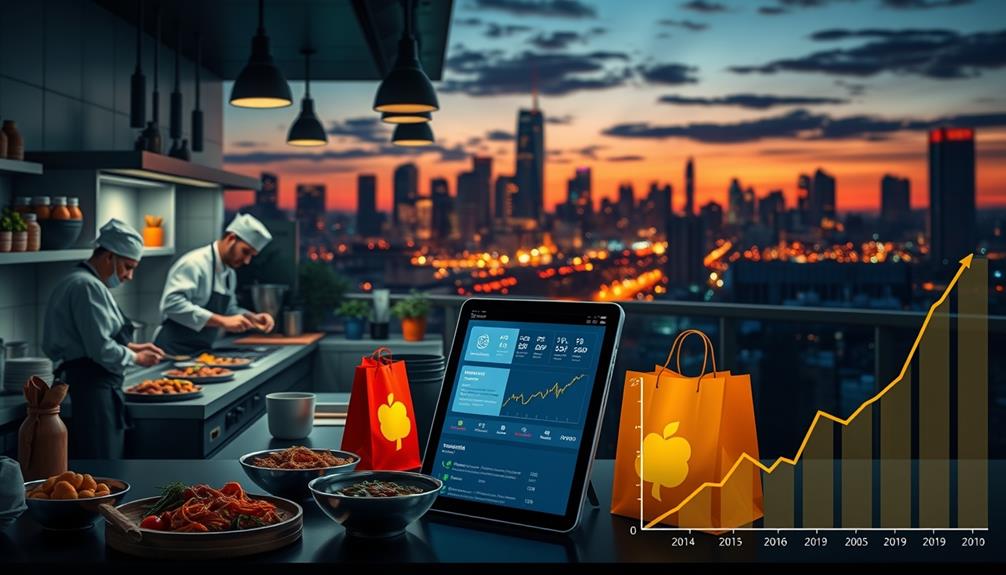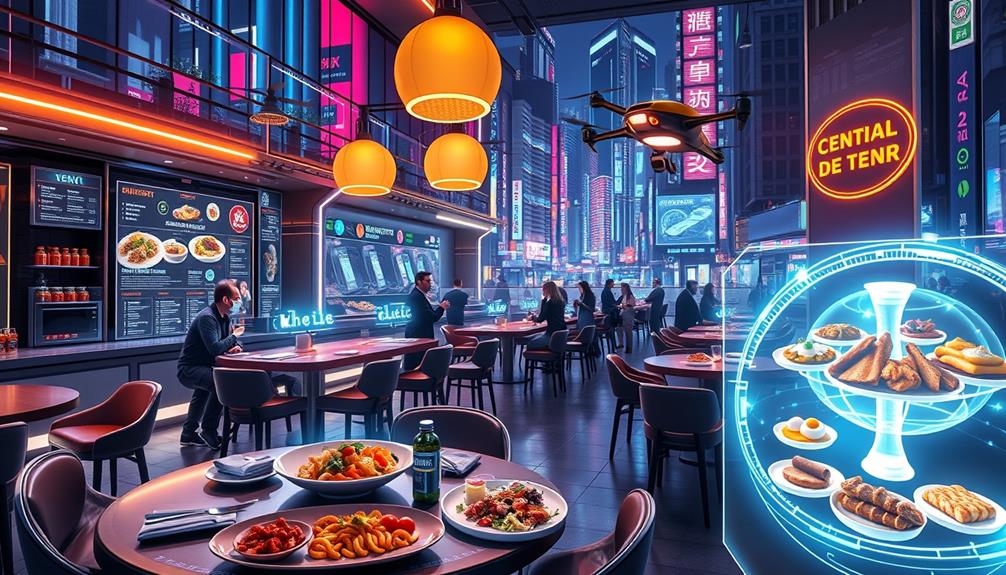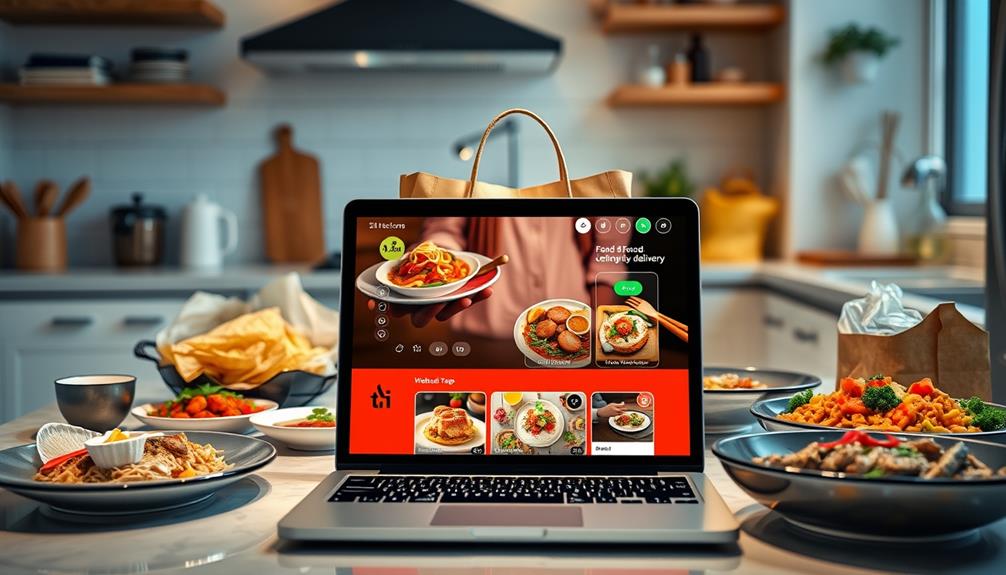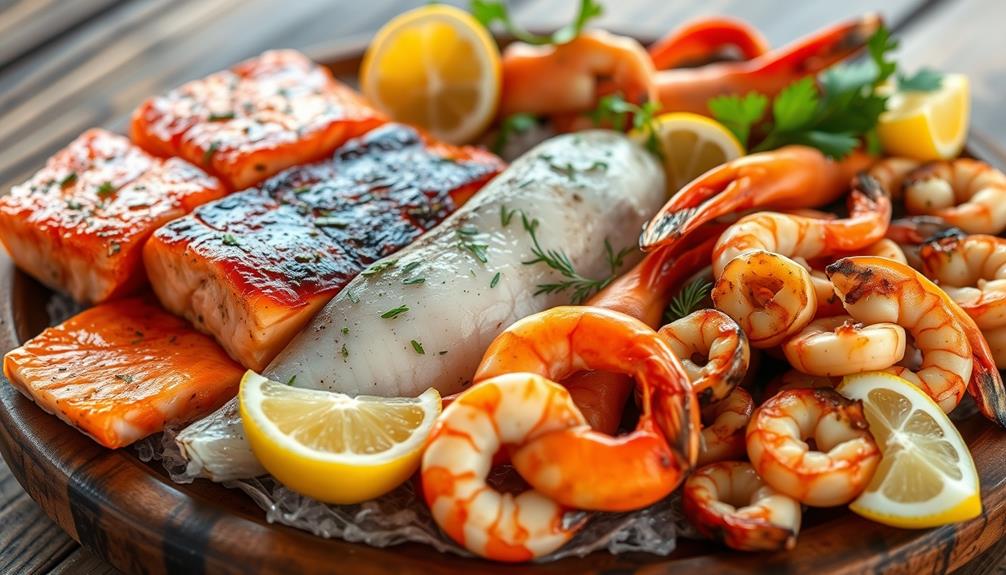A virtual restaurant operates entirely online, using ghost kitchens that allow for food delivery without a physical dining space. You won't find them in your local neighborhood; instead, they rely on online platforms and apps like Grubhub or DoorDash. This model cuts overhead costs and enables multiple brands to share a single kitchen, making it easier to experiment with menu items. As this market grows rapidly, competition increases, requiring unique offerings to stand out. If you're curious about how they navigate challenges and what the future holds for virtual dining, stay tuned for more insights.
Key Takeaways
- Virtual restaurants operate exclusively online and focus on food delivery without a physical dining space.
- They utilize ghost kitchens to reduce overhead costs associated with traditional restaurant operations.
- The market for virtual restaurants is projected to reach $1 trillion by 2030 due to rising demand for delivery services.
- Multiple brands can share kitchen space, allowing for efficient resource use and rapid experimentation with new menu items.
- Consumer skepticism exists regarding food origins and quality, highlighting the need for transparency in the virtual restaurant model.
Definition of Virtual Restaurants

A virtual restaurant is a dining concept that exists exclusively online, catering to customers through food delivery without a physical dining space. This innovative approach often utilizes ghost kitchens, also known as shared kitchens, allowing restaurant operators to create delivery-only restaurant brands without the overhead costs of traditional brick-and-mortar locations.
The rise of online ordering and third-party delivery apps has led to a significant shift in consumer preferences, as many now favor the convenience of delivery options over traditional dining experiences; this aligns with the growing interest in unique culinary concepts, reminiscent of the charm and allure associated with diverse astrological signs.
Successful virtual brands, like MrBeast Burger and Cosmic Wings, showcase how leveraging existing kitchen spaces can generate incremental revenue. These brands not only meet customer needs but also capitalize on the evolving dining landscape.
As a restaurant operator, adopting the virtual restaurant concept can enhance your business's adaptability and resilience, especially in a post-pandemic world. Embracing this trend could be your ticket to thriving in a competitive market while keeping pace with consumer preferences.
Market Trends and Growth

The virtual restaurant market is booming, fueled by a growing appetite for food delivery services that surged during the COVID-19 pandemic. By 2030, it's projected to reach a staggering $1 trillion. The delivery-only concept has captured consumer interest, with brands like "It's Just Wings" skyrocketing to an estimated $150 million shortly after launch.
This rapid growth is also influenced by significance of keyword research, helping businesses identify and optimize for consumer demands.
Several key trends are shaping this growth:
- Rise of food delivery apps: Platforms like Grubhub and DoorDash have expanded access to a wider customer base, making it easier for ghost restaurants to thrive without physical locations.
- Efficiency in kitchen space: Virtual restaurants can operate multiple brands from a single kitchen, allowing for experimentation based on customer feedback and market research.
- Adapting business models: As consumer preferences shift toward convenience, these restaurants are innovating to meet demands.
- Competitive analysis: Understanding competitors is vital to navigate challenges, like high commission fees from delivery platforms that can reach up to 30%.
Operational Dynamics

Steering the operational dynamics of virtual restaurants reveals a unique blend of efficiency and innovation. By utilizing ghost kitchens, these establishments maximize their resources, allowing multiple brands to share kitchen spaces for food preparation and delivery service. This model considerably reduces overhead costs associated with traditional dining experiences, enabling a focused delivery-only approach.
Additionally, understanding common financial terms can help restaurant owners manage their finances effectively.
Online platforms play a pivotal role in processing orders, streamlining operations while catering to customer preferences. With the help of data analytics, you can track what menu items resonate with your audience, adjusting offerings based on real-time feedback and trends. This adaptability is essential for staying relevant in a fast-paced market.
High-quality food production is achievable in expansive shared kitchen spaces, typically around 6,000 square feet or more, where staff can efficiently support various virtual brands.
The flexibility inherent in virtual restaurants fosters rapid experimentation with new menu items and concepts, allowing you to align your offerings with current food trends and diverse tastes. In this dynamic environment, understanding operational workflows and customer insights not only enhances service but also drives growth in an ever-evolving culinary landscape.
Consumer Perception and Criticism

Often, consumers find themselves perplexed by virtual restaurants, primarily due to a lack of transparency regarding their origins. This confusion can lead to skepticism surrounding food authenticity and the overall reliability of these delivery-only concepts.
Many people may not realize that these brands often stem from established brick-and-mortar restaurants, which can complicate their perception. Additionally, understanding the financial implications associated with virtual dining can further illuminate why some consumers may feel uneasy about these options.
Several key factors contribute to the mixed consumer perception of virtual restaurants:
- Transparency: Without clear information about where food comes from, trust erodes.
- Working Conditions: Concerns around cramped and windowless kitchens raise questions about employee welfare and food safety.
- Ethical Issues: When virtual brands mimic popular high-street restaurants, it misleads customers regarding the food's quality and origin.
- High Commission Fees: These fees from third-party delivery services often inflate prices, which may compromise quality due to cost-cutting measures.
As a result, you might find yourself questioning whether the convenience of virtual dining is worth the potential compromises in quality and ethics.
Understanding these issues can help you make more informed choices when ordering in.
Future Outlook and Challenges

As the virtual restaurant industry approaches a staggering $1 trillion market by 2030, it faces a unique blend of opportunities and challenges. With ongoing consumer demand for delivery and innovative culinary concepts, you might think the future looks bright.
However, increased competition is leading to brand saturation, making it essential for virtual restaurants to offer unique and enticing options to keep customers engaged. Similar to the diversification strategies in gold IRAs, virtual restaurants must explore various culinary offerings to stand out in a crowded market.
Maintaining food quality and customer satisfaction is crucial, especially as rapid expansion can strain resources. Any decline in quality could harm your brand's reputation and profitability.
Additionally, as the model becomes more mainstream, expect heightened regulatory scrutiny. Compliance with local food safety and labor regulations will be imperative to operate without interruptions.
Moreover, adapting to changing consumer preferences, including the push for sustainable practices and eco-friendly packaging, isn't just a trend; it's a requirement for long-term success.
Frequently Asked Questions
What Is the Point of a Virtual Restaurant?
The point of a virtual restaurant is to provide convenient, diverse meal options without the overhead of a physical space. You can enjoy varied cuisines delivered right to your door, tailored to your preferences and feedback. Furthermore, virtual restaurants often eliminate the need for traditional restaurant host responsibilities, such as seating and greeting guests. Instead, the focus is on efficient ordering, preparation, and delivery of high-quality meals. This allows for a more streamlined and customizable dining experience for the customer, while also reducing operational costs for the restaurant. Overall, virtual restaurants are redefining the dining experience by leveraging technology to meet the changing demands of modern consumers.
What Is a Virtual Restaurant on Grubhub?
When you order from a virtual restaurant on Grubhub, you're choosing a delivery-only option that may share a kitchen with another restaurant. These spots often lack signage, so follow pickup instructions carefully for a smooth experience.
What Is the Point of Ghost Restaurants?
Imagine a chameleon, adapting swiftly to its environment. Ghost restaurants thrive by minimizing costs and maximizing flexibility, letting you explore diverse menus and enjoy convenience while catering to your ever-changing craving for delicious food.
Is a Virtual Restaurant the Same as a Ghost Kitchen?
No, a virtual restaurant isn't the same as a ghost kitchen. While both focus on delivery, virtual restaurants have unique branding and menus, whereas ghost kitchens often host multiple brands without distinct identities.
Conclusion
To sum up, virtual restaurants are like the hidden gems in a bustling city; they may not have a physical storefront, but they offer unique dining experiences that cater to modern tastes. As you explore this evolving landscape, remember that the convenience of ordering in can sometimes lead you to culinary treasures you never knew existed. Just like finding a cozy café tucked away on a side street, virtual restaurants invite you to savor the unexpected delights of food delivered right to your door.









